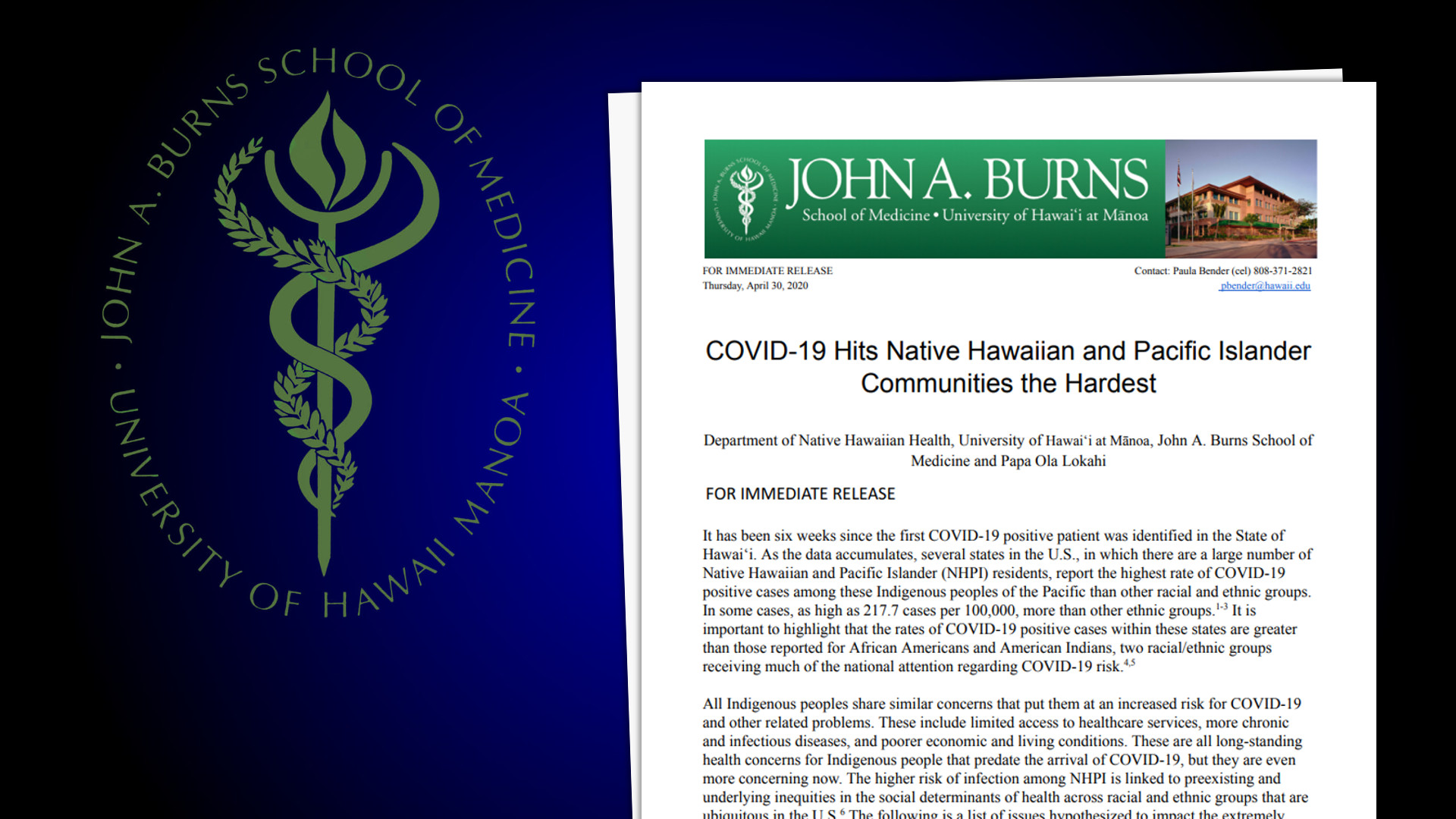(BIVN) – Data shows Native Hawaiians and Pacific Islanders are the highest rate of COVID-19 positive cases among Indigenous peoples of the Pacific than other racial and ethnic groups. The rate is as high as 217.7 cases per 100,000, says the John A. Burns School of Medicine.
Professor Keawe‘aimoku Kaholokula, PhD, and Assistant Professor Robin E. S. Miyamoto, Psy.D., both of the Department of Native Hawaiian Health at the John A. Burns School of Medicine at the University of Hawaii at Manoa, presented their findings in this media release from JABSOM and Papa Ola Lokahi:
It has been six weeks since the first COVID-19 positive patient was identified in the State of Hawai‘i. As the data accumulates, several states in the U.S., in which there are a large number of Native Hawaiian and Pacific Islander (NHPI) residents, report the highest rate of COVID-19 positive cases among these Indigenous peoples of the Pacific than other racial and ethnic groups. In some cases, as high as 217.7 cases per 100,000, more than other ethnic groups. It is important to highlight that the rates of COVID-19 positive cases within these states are greater than those reported for African Americans and American Indians, two racial/ethnic groups receiving much of the national attention regarding COVID-19 risk.
All Indigenous peoples share similar concerns that put them at an increased risk for COVID-19 and other related problems. These include limited access to healthcare services, more chronic and infectious diseases, and poorer economic and living conditions. These are all long-standing health concerns for Indigenous people that predate the arrival of COVID-19, but they are even more concerning now. The higher risk of infection among NHPI is linked to preexisting and underlying inequities in the social determinants of health across racial and ethnic groups that are ubiquitous in the U.S. The following is a list of issues hypothesized to impact the extremely high rates of COVID-19 in NHPIs:
1. High rates of chronic disease. NHPI have among the highest rates of these chronic medical conditions, and associated mortality rates, than other ethnic groups in Hawai‘i as well as the larger U.S., and among the highest in the world for those in the Pacific nations and territories, such as the Marshall Islands and Guam. These rates put them in the highly vulnerable category in the event they are infected.
2. High rates of smoking and vaping. NHPI, especially adolescents and young adults, have the highest rates of smoking and vaping compared to other racial and ethnic groups. Smoking and vaping thicken the air sacs and cause inflammation of the lungs, which makes a person highly susceptible to severe symptoms should they contract COVID-19.
3. Poor access to quality health care. About 20% of NHPI are uninsured compared to 11.4% of non-Hispanic whites.
4. Overrepresentation in category of essential worker. A large percentage of the NHPI community is comprised of essential workers, with heavy representation in the military, security, service, and healthcare industry, who are at an increased risk of contracting COVID-19 due to greater face-to-face interaction with patrons and co-workers.
5. Lower wages and poorer economic and living conditions. Service-related jobs often do not provide a livable wage. NHPI are more likely than many other ethnic groups to have fewer financial resources and live in larger multi-generational households and densely populated neighborhoods.
6. Overrepresentation in incarcerated and homeless population. Native Hawaiians alone comprise 43% of the prison population and, on Oʻahu alone, 39% of the homeless population. It is difficult to practice social distancing in prison or while living on the streets, and the conditions are unsanitary in these environments.
Although an issue not directly linked to the medical side of the COVID-19 crisis, the ‘shelter at home’ and ‘social distancing’ measures to stop the spread of COVID-19 are placing a heavy emotional toll on NHPI communities. In particular are the psychosocial and financial stressors caused by the COVID-19 crisis leading to elevated levels of interpersonal violence and substance abuse in our NHPI communities. Before COVID-19, the prevalence of interpersonal violence and substance abuse were already high among many NHPI communities so any increases will surely have detrimental and long-term repercussions, making recovery efforts more challenging.
Despite the higher COVID-19 risk among NHPI, it is important to remember and recognize the resiliency and fortitude of NHPI communities and their cultural assets that can be leveraged to reduce the adverse impact of COVID-19. Despite two centuries of colonization, occupation, and exploitation by Western powers, NHPI communities continue to flourish while maintaining their unique cultural values, perspectives, practices, and aspirations. The value and practice of Aloha(compassion), Mālama (caring), and Lōkahi (unity), although said differently across the different NHPI languages, provide the guiding principles to overcome any challenge.
This data compels us to act immediately to develop a plan in Hawai‘i and across the continental U.S. that includes ongoing data collection, ensure essential workers are protected (e.g., provided with personal protective equipment), free COVID-19 testing, paid sick leave and hazard pay. The COVID crisis has brought clarity to the structural racism that has created these inequities and we need to engage in the critical conversations while we have the opportunity. We are partnering with the American Psychological Association in their initiative “Equity Flattens the Curve” #EquityFlattensTheCurve. We are hopeful that we can shine a light and begin to make meaningful changes.


by Big Island Video News12:07 am
on at
STORY SUMMARY
HAWAIʻI - Keaweʻaimoku Kaholokula, PhD, and his team have determined that Native Hawaiians and Pacific Islanders report the highest rate of COVID-19 positive cases among Indigenous peoples of the Pacific than other racial and ethnic groups.